-
 Bitcoin
Bitcoin $118400
0.47% -
 Ethereum
Ethereum $3836
2.20% -
 XRP
XRP $3.157
2.98% -
 Tether USDt
Tether USDt $0.9999
-0.03% -
 BNB
BNB $801.5
1.31% -
 Solana
Solana $180.9
2.07% -
 USDC
USDC $0.9999
-0.02% -
 Dogecoin
Dogecoin $0.2225
2.50% -
 TRON
TRON $0.3285
-1.02% -
 Cardano
Cardano $0.7789
2.60% -
 Hyperliquid
Hyperliquid $43.60
2.39% -
 Sui
Sui $3.892
4.41% -
 Stellar
Stellar $0.4229
3.34% -
 Chainlink
Chainlink $18.01
3.98% -
 Hedera
Hedera $0.2745
6.77% -
 Bitcoin Cash
Bitcoin Cash $582.3
3.38% -
 Avalanche
Avalanche $23.77
1.04% -
 Ethena USDe
Ethena USDe $1.001
0.01% -
 Toncoin
Toncoin $3.493
3.59% -
 Litecoin
Litecoin $110.0
2.48% -
 UNUS SED LEO
UNUS SED LEO $8.936
-0.37% -
 Shiba Inu
Shiba Inu $0.00001304
2.49% -
 Uniswap
Uniswap $9.999
1.09% -
 Polkadot
Polkadot $3.897
3.26% -
 Monero
Monero $308.6
-0.83% -
 Dai
Dai $0.9999
-0.01% -
 Bitget Token
Bitget Token $4.504
-0.04% -
 Pepe
Pepe $0.00001154
2.95% -
 Cronos
Cronos $0.1471
3.06% -
 Ethena
Ethena $0.6691
19.53%
What does it mean when the trading volume shrinks continuously and then suddenly breaks through with a large volume?
A sustained drop in trading volume often signals market consolidation, while a sudden spike on high volume may confirm a breakout, indicating renewed investor conviction.
Jul 30, 2025 at 09:49 am
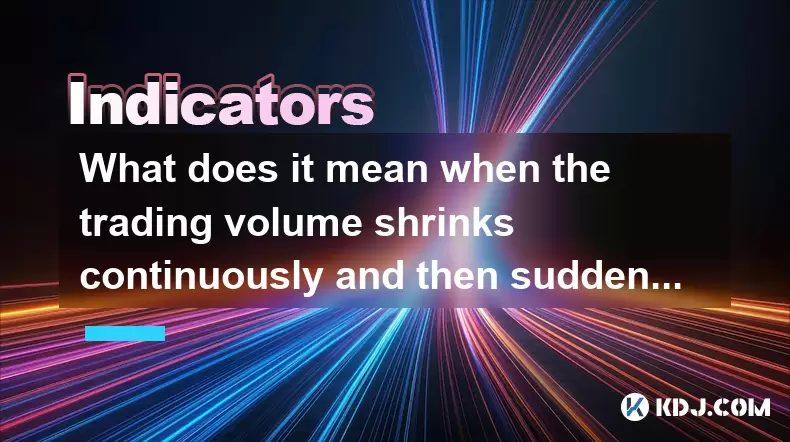
Understanding Trading Volume in Cryptocurrency Markets
Trading volume refers to the total number of units of a cryptocurrency traded over a specific period, typically 24 hours. It serves as a critical indicator of market activity and liquidity. When trading volume shrinks continuously, it often reflects a period of consolidation or indecision among market participants. During such phases, fewer traders are actively buying or selling, which may lead to narrow price ranges and reduced volatility. This shrinking volume can suggest that the market is awaiting a catalyst—such as news, macroeconomic data, or technical breakouts—before resuming a directional move. In this context, low volume is commonly interpreted as a sign of weakening momentum in the current trend.
Interpreting Continuous Volume Decline
A consistent drop in trading volume over several days or weeks may signal that interest in a particular cryptocurrency is waning. This can happen after a strong price movement, where early participants take profits and new entrants hesitate to join. In technical analysis, this phase is often associated with "accumulation" or "distribution" zones, depending on whether smart money is quietly building positions or exiting. Traders monitor volume patterns closely because a prolonged period of shrinking volume often precedes a significant price movement. The key insight here is that low volume does not imply stagnation—it may instead represent a coiling phase where market energy is building beneath the surface.
Significance of a Sudden Volume Surge
When a cryptocurrency that has been trading on shrinking volume suddenly experiences a large spike in trading volume, it typically indicates a breakout or breakdown from a consolidation pattern. This surge often accompanies a sharp price movement, either upward or downward, and reflects renewed interest from institutional or retail investors. A breakout on high volume is considered more credible than one on low volume, as it suggests strong conviction behind the move. For example, if Bitcoin has been trading sideways with declining volume for two weeks and then surges 10% on triple its average volume, this could signal the start of a new bullish trend. The high volume confirms participation and reduces the likelihood of a false breakout.
Analyzing Breakout Scenarios with Volume Confirmation
To determine whether a sudden volume spike is meaningful, traders apply several analytical techniques:
- Compare current volume to average volume: A volume that exceeds the 20-day average by 150% or more is often considered significant.
- Check price action at key levels: If the breakout occurs near a well-known resistance or support level, the volume spike adds credibility.
- Examine order book depth: A surge in volume should ideally be supported by thick order books on the dominant exchanges, indicating real buying or selling pressure.
- Monitor for follow-through: A single high-volume day is not enough; sustained volume in the following sessions confirms the breakout’s validity.
- Use volume indicators: Tools like On-Balance Volume (OBV) or Volume Weighted Average Price (VWAP) help assess whether volume is supporting the price trend.
For instance, if Ethereum consolidates between $3,000 and $3,200 for ten days with declining volume and then closes above $3,200 on a volume 200% higher than average, this is a strong signal that buyers have taken control. The breakout on high volume suggests that new capital is entering the market, potentially driving further price increases.
Spotting Potential False Breakouts and Traps
Not all high-volume breakouts lead to sustained trends. Some are "bull traps" or "bear traps" designed to lure retail traders into unfavorable positions. A bull trap occurs when price breaks above resistance on high volume but quickly reverses, trapping buyers. To avoid such scenarios: - Wait for closing confirmation: A breakout should ideally be confirmed by a daily or 4-hour candle closing beyond the key level.
- Look for volume distribution across exchanges: If the volume spike is concentrated on a single low-liquidity exchange, it may be manipulated.
- Check for news or events: Sudden volume spikes without fundamental catalysts may indicate wash trading or spoofing.
- Analyze time-of-day patterns: Unusual volume surges during low-activity hours (e.g., Asian market lull) warrant caution.
For example, if Solana breaks above $150 on high volume but the surge occurs during a U.S. holiday when most institutional traders are inactive, the move may lack genuine support and reverse quickly.
Practical Steps to Respond to Volume Breakouts
When you observe a cryptocurrency transitioning from low to high volume with a price breakout, consider the following actions: - Verify the volume spike on multiple exchanges: Use platforms like CoinGecko or CoinMarketCap to cross-check volume data.
- Set up price alerts: Use exchange tools or third-party apps to notify you when volume exceeds a threshold.
- Adjust stop-loss and take-profit levels: If you're already holding the asset, a breakout may warrant tightening stops or scaling out of positions.
- Enter with caution: Use limit orders slightly above breakout levels to avoid chasing price.
- Track on-chain metrics: Tools like Glassnode can show whether the volume surge correlates with large wallet movements or exchange inflows/outflows.
For example, if you're monitoring Cardano and notice volume jumping from 50 million ADA traded daily to 150 million after a prolonged consolidation, you can use a limit buy order at 1-2% above the breakout point to manage risk while participating in potential upside.
Frequently Asked Questions
Can shrinking volume occur during a strong trend?
Yes, shrinking volume can appear even in strong trends, particularly during parabolic moves where few traders are willing to sell. However, sustained price increases on declining volume may indicate weakening momentum and potential exhaustion.How do I distinguish between organic volume and wash trading?
Organic volume is typically distributed across multiple reputable exchanges and aligns with price movements and order book depth. Wash trading often shows up as repetitive, round-number trades on obscure exchanges with little price impact and can be flagged using blockchain analysis tools.Does a high-volume breakout always lead to a long-term trend?
No, a high-volume breakout does not guarantee a sustained trend. It increases the probability of continuation, but confirmation through follow-up price action and volume is essential. Many breakouts fail within days despite strong initial volume.What tools can I use to monitor real-time volume changes?
You can use TradingView for chart-based volume analysis, CoinGlass for derivatives volume, and CryptoQuant for on-chain volume metrics. Exchange-specific APIs also allow custom alerts for volume spikes.
Disclaimer:info@kdj.com
The information provided is not trading advice. kdj.com does not assume any responsibility for any investments made based on the information provided in this article. Cryptocurrencies are highly volatile and it is highly recommended that you invest with caution after thorough research!
If you believe that the content used on this website infringes your copyright, please contact us immediately (info@kdj.com) and we will delete it promptly.
- Ozak AI: Can This Underdog Crypto Achieve a Bull Run to $1?
- 2025-07-31 22:30:12
- Coinbase Breach: Navigating Insider Risk and Bolstering Security
- 2025-07-31 23:11:55
- Bitcoin Rebounds, WeWake Presale Gains Traction: What's the Buzz?
- 2025-07-31 22:30:12
- Bitcoin, Altcoins, and Volume Watchlists: Decoding the Crypto Landscape
- 2025-07-31 23:11:55
- Tron, Fartcoin, and BlockchainFX: What's Trending (and What's Not) in the Crypto World
- 2025-07-31 21:32:19
- Bitcoin, Corporate Investments, and Sustainability: A New Era or Fleeting Fad?
- 2025-07-31 20:50:14
Related knowledge

How can you use the MACD histogram to determine trend strength?
Jul 31,2025 at 11:10pm
Understanding the MACD Histogram and Its ComponentsThe MACD (Moving Average Convergence Divergence) histogram is a visual representation of the differ...
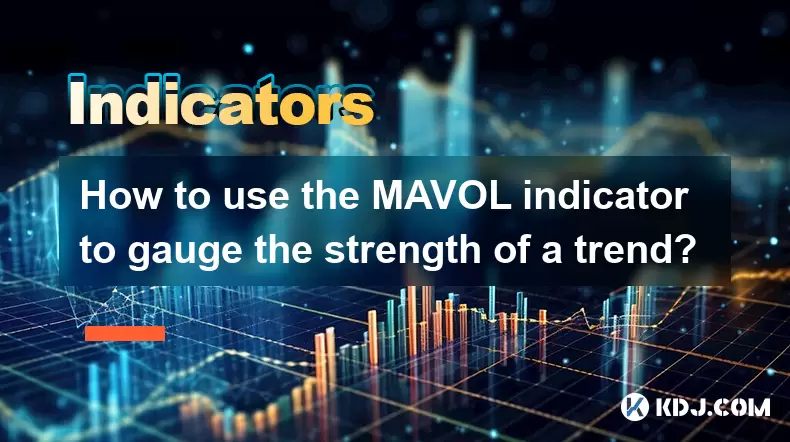
How to use the MAVOL indicator to gauge the strength of a trend?
Jul 31,2025 at 09:57pm
Understanding the MAVOL Indicator in Cryptocurrency TradingThe MAVOL indicator, short for Moving Average of Volume, is a technical analysis tool widel...
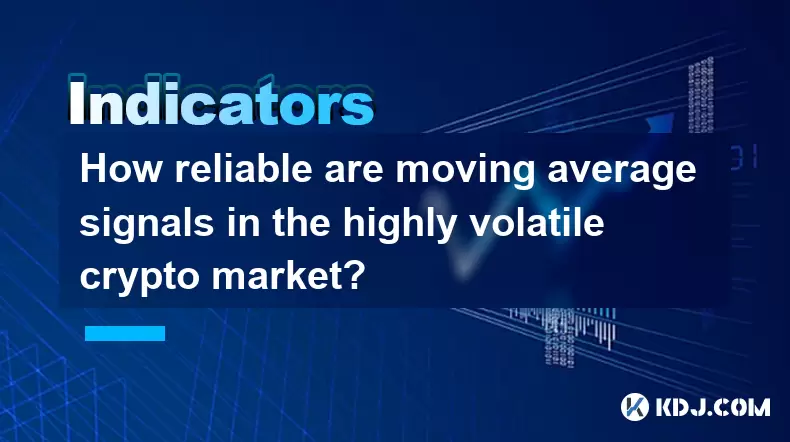
How reliable are moving average signals in the highly volatile crypto market?
Jul 31,2025 at 08:36pm
Understanding Moving Averages in Cryptocurrency TradingMoving averages (MAs) are among the most widely used technical indicators in the cryptocurrency...
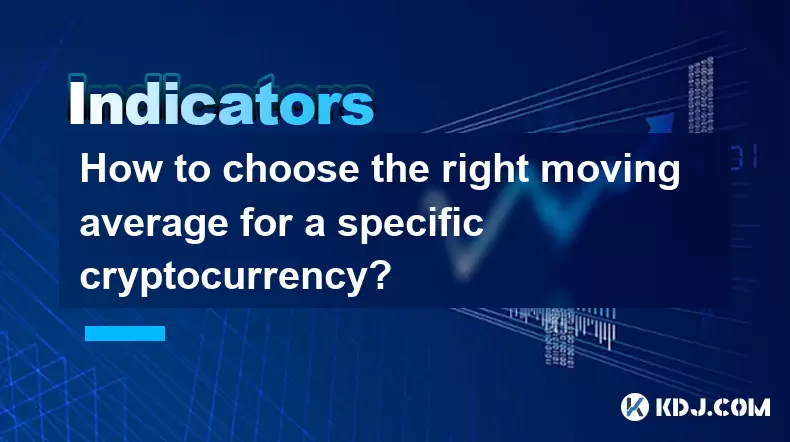
How to choose the right moving average for a specific cryptocurrency?
Jul 31,2025 at 10:29pm
Understanding the Role of Moving Averages in Cryptocurrency TradingMoving averages are foundational tools in technical analysis, widely used by crypto...
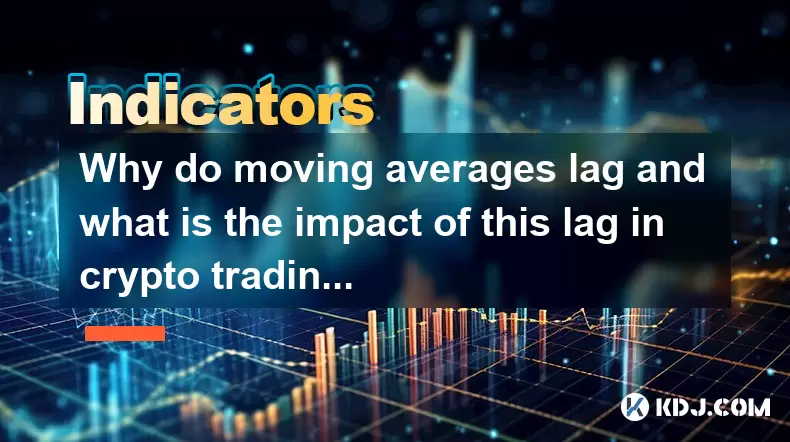
Why do moving averages lag and what is the impact of this lag in crypto trading?
Jul 31,2025 at 08:07pm
Understanding the Concept of Moving Averages in Crypto TradingMoving averages are among the most widely used technical indicators in cryptocurrency tr...
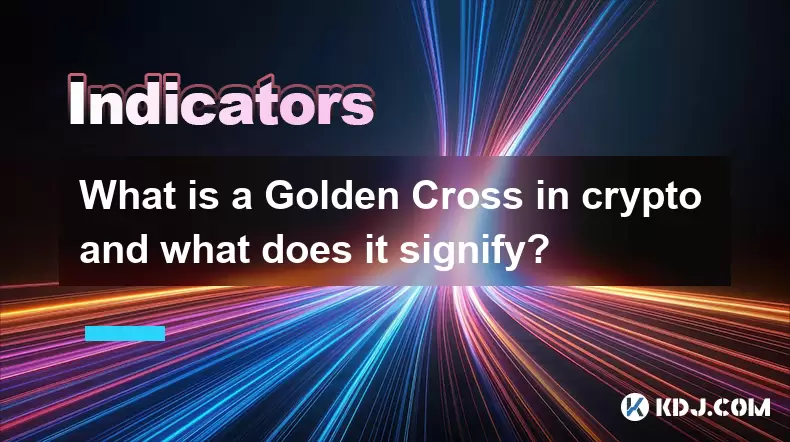
What is a Golden Cross in crypto and what does it signify?
Jul 31,2025 at 10:36pm
Understanding the Golden Cross in Cryptocurrency MarketsThe Golden Cross is a technical analysis pattern widely observed in cryptocurrency trading. It...

How can you use the MACD histogram to determine trend strength?
Jul 31,2025 at 11:10pm
Understanding the MACD Histogram and Its ComponentsThe MACD (Moving Average Convergence Divergence) histogram is a visual representation of the differ...

How to use the MAVOL indicator to gauge the strength of a trend?
Jul 31,2025 at 09:57pm
Understanding the MAVOL Indicator in Cryptocurrency TradingThe MAVOL indicator, short for Moving Average of Volume, is a technical analysis tool widel...

How reliable are moving average signals in the highly volatile crypto market?
Jul 31,2025 at 08:36pm
Understanding Moving Averages in Cryptocurrency TradingMoving averages (MAs) are among the most widely used technical indicators in the cryptocurrency...

How to choose the right moving average for a specific cryptocurrency?
Jul 31,2025 at 10:29pm
Understanding the Role of Moving Averages in Cryptocurrency TradingMoving averages are foundational tools in technical analysis, widely used by crypto...

Why do moving averages lag and what is the impact of this lag in crypto trading?
Jul 31,2025 at 08:07pm
Understanding the Concept of Moving Averages in Crypto TradingMoving averages are among the most widely used technical indicators in cryptocurrency tr...

What is a Golden Cross in crypto and what does it signify?
Jul 31,2025 at 10:36pm
Understanding the Golden Cross in Cryptocurrency MarketsThe Golden Cross is a technical analysis pattern widely observed in cryptocurrency trading. It...
See all articles

























































































